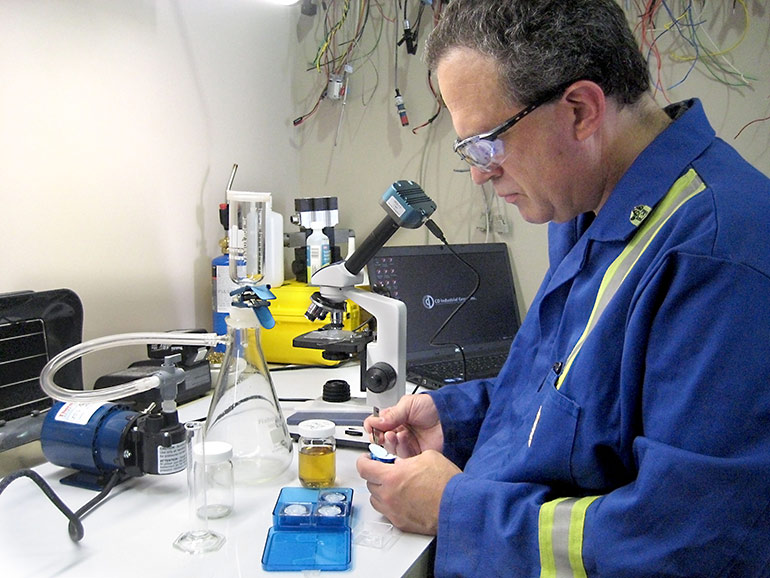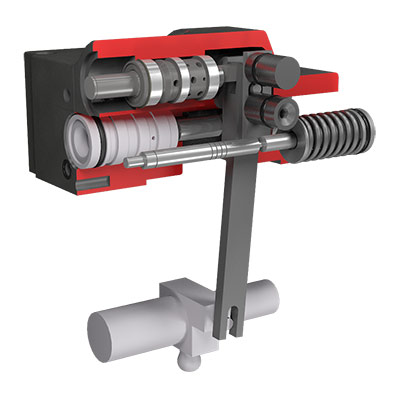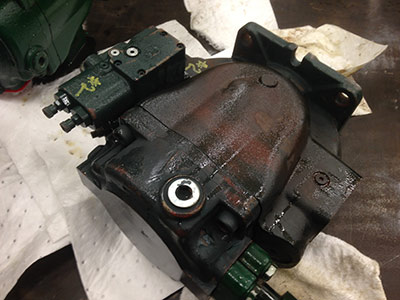In our recent Engineering Week, I sat down with Carl Dyke, founder of LunchBox Sessions and CD Industrial, to talk about hydraulic system troubleshooting. In this multi-part series based on that conversation, we’re going to look at why hydraulic systems fail, how system maintainers can prevent failures, and tips and tricks to troubleshoot problems and failures easily.
Before beginning to troubleshoot a machine, Dyke said it’s critical to understand why machines fail in the first place. Is it just time and wear and tear? Do specific components fail more commonly than others?

Carl Dyke tests oil samples for particulate contamination.
There are a variety of reasons, he said, but one of the key reasons hydraulic systems fail is misuse. “Sometimes people are expecting that hydraulic system to do things that the engineers and designers just didn’t intend for it. And when you push things a little too hard beyond the design parameters, something’s got to give. A system is always going to find its weakest link,” he said. “It’s amazing how creative humans can be at pushing the envelope. Probably in a lot of cases that I’m mentioning, it would probably be a mobile machine, but it can happen to a machine in a stationary or factory environment as well.”

Valves and pump controllers have many parts that can seize due to contaminants.
Failure to care for the machine is a huge misstep in the industry as well. “Hydraulic machines are robust so it’s easy to just start operating, then forget that they need somebody to give it some tender, loving care at times and look after some of its needs from the maintenance side,” Dyke said.
Perhaps one of the most typical failures comes with hydraulic valves that get stuck, Dyke indicated. “They get stuck on the inside. That can include a pump controller. A lot of pumps these days have a very sophisticated controller bolted on, which is typically some type of valving, and they get stuck,” he said. “And somebody must figure out where is that internal sticking.”
Additionally, another key issue comes when settings change. This can be caused because of too many overheating cycles that happened along the way. Or perhaps the system operator or a maintenance technician experimented a little bit and adjusted something. In some cases, vibration may have turned an adjustment screw, and so things have come loose. These little things mean users and maintainers may be unaware that an adjustable setting on the machine may have changed.
Obviously, said Dyke, the biggest issues come from unwelcome contaminants — hard particles and water — that get inside the system. “It’s amazing how often little bits of water, especially in a system that’s not being run continuously, can cause things to go wrong.”
Finally, a common issue especially with today’s systems is that wires can fall off, Dyke said. Most hydraulic systems today have electronic or electrical elements connected to it, and those wires can disconnect and fall off.

Severe overheating means paint can change from brown to black, offering a clear indication something is wrong.
Dyke said it’s difficult to get to the point of the problem in hydraulic systems because it’s rarely obvious from the outside. Visual indications of failure or a problem within the system could include fluid leakage or a color change in the system. “In some cases, if the component has changed color, you may have a problem with your pump, for example,” he said. “What we find in our travel is that just about every color of paint can eventually become black, it seems. But it’s almost like toasting a marshmallow. The first color along the way will be nice golden brown and then eventually black. And so, yeah, if you get to brown or black when your paint color was blue or white or green or something else, then you have an obvious clue from the outside.
“But so many little subtle things can go wrong in a hydraulic system, and there’s no easy clue from the outside as to where the cause is. You can see where the symptom is, some problem with motion or force or what have you, but where the cause is — that can be over a pretty wide roadmap of locations,” Dyke concluded.
To help users recognize common faults, Dyke listed a few issues that can occur on the production side of a machine that will indicate a problem.
“One of the first ones that everybody reports is some kind of a problem with speed. The machine isn’t keeping up. The hydraulic cylinders are slower at getting their job done. The hydraulic motors are slower,” he said. “We tend to notice that the production line has slowed down, or if it’s a mobile machine, that it won’t do its job as quickly as it did before.”
Secondly, lack of power or force is a common symptom that something is wrong. “The machine won’t lift as much as it used to. It won’t dig in the hard dirt. If it’s a press, it’s not squeezing the product in the plant the way it used to,” Dyke described. “And then, of course, you’re looking for a pressure issue usually at that point.”
Next, look for systems that don’t run smoothly or are difficult to control. And finally, pay attention to hydraulic system overheating.
In the next installment on this series, look for a continuation of this discussion, as Dyke delves into some easy tips to follow to help diagnose your system problems.
LunchBox Sessions
www.lunchboxsessions.com
CD Industrial
www.cdiginc.com
Filed Under: Engineering Basics, Trending